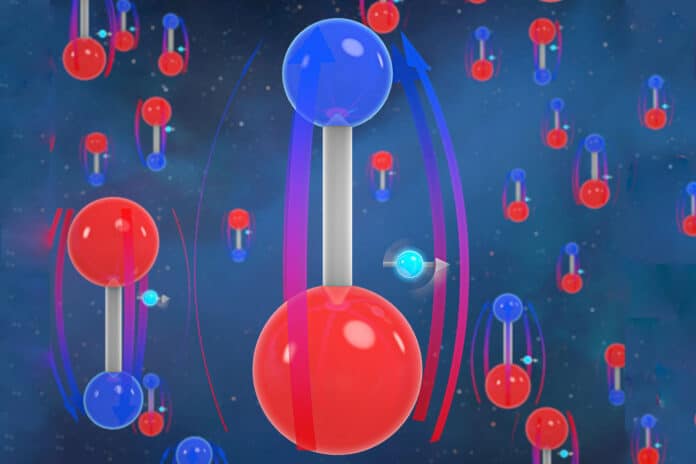The imbalance of matter and antimatter in our Universe provides compelling motivation to search for undiscovered particles that violate charge-parity symmetry. Interactions with vacuum fluctuations of the fields associated with these new particles will induce an electric dipole moment of the electron (EDM).
Now, the JILA group has made a record-breaking measurement of electrons, narrowing the search for where this asymmetry came from.
The electron’s electric dipole moment (EDM) is one place to check for signs of asymmetry. The EDM describes the distribution of the negative electric charge that constitutes an electron’s north and south poles. Asymmetry would be confirmed by any eEDM measurement above zero; the electron would resemble an egg rather than a circle. However, no one is certain just how slight that variation might be.
Tanya Roussy, a graduate student in Cornell’s research group at JILA, said, “We need to fix our math to be closer to reality. We’re looking for where that asymmetry might be, so we can understand where it came from. Electrons are fundamental particles, and their symmetry tells us about the symmetry of the Universe.”
Scientists recently set a record for precision measurement of eEDM, improving on previous measurements by a factor of 2.4.
How exactly was that? Their research discovered that any asymmetry would be smaller than the radius of an atom if an electron were the size of the Earth, according to Roussy.
She continues that making a measurement so exact is quite challenging, so the team had to be resourceful. The scientists examined hafnium fluoride molecules. Non-round electrons would want to align with the field and move around inside the molecules if a strong electric field were given to the molecules. The electrons wouldn’t move if they were rounded.
By removing electrons from molecules using an ultraviolet laser, they created a collection of positively charged ions and trapped them. The electromagnetic field surrounding the trap was alternated, forcing the molecules to align. The energy levels of the two groups were then measured by the researchers using lasers. If their levels were dissimilar, the electrons must be asymmetrical.
Their experiment had longer measurement times than in earlier attempts, which increased their sensitivity. However, the team’s observations revealed that the electrons didn’t change energy levels, proving that electrons are round to the best of our current measurement capabilities.
Cornell notes that while finding a nonzero measurement of eEDM is not certain, the achievement of this degree of precision from a tabletop experiment is. It demonstrates numerous alternatives to using pricey particle accelerators to investigate these fundamental cosmological concerns. Although the study didn’t discover asymmetry, their findings will aid the field’s continued search for explanations for the asymmetry of the early Universe.
Roussy said, “We found the electron is symmetric up to our measurement. If we would have found nonzero, it would be a big deal. The best bet is to have teams of scientists worldwide looking at different options. As long as we all keep measuring the truth, eventually, someone will find it.”
Journal Reference:
- Tanya S. Roussy, Luke Caldwell, Trevor Wright, William B. Cairncross, Yuval Shagam, Kia Boon Ng, Noah Schlossberger, Sun Yool Park, Anzhou Wang, Jun Ye, and Eric A. Cornell. A new bound on the electron’s electric dipole moment. Science. DOI: 10.1126/science.adg4084
